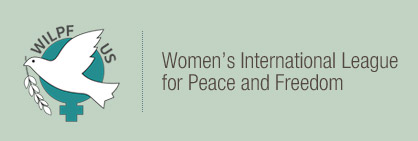New Guides for Taking Action on Reducing US Military Budget
Published on April, 00 2021
What could we do with $74B taken from the Pentagon’s budget? Graphic used with permission from the National Priorities Project at the Institute for Policy Studies.
Cherrill Spencer
Coordinator of Resource Preparation Team for the Call for Peace Campaign
Nancy Price
Team Member
April 2021
WILPF US continues our Call for Peace Campaign which we described in February 2021 and March 2021 eNews articles. We promised you some resource guides on why we must reduce the United States’ bloated military budget and where that saved money could be used to benefit human need. Now we have four new guides for you with background information and actions that you can take.
Your First Action to Get the Money Moving!
Under the National Defense Authorization Act (NDAA) process, every year both chambers of Congress begin early in the year to discuss the military budget and any differences must be reconciled before the final vote and the President signs the bill. Now they are already hard at work on Fiscal Year 2022. For this reason, our most efficient action to influence the amount of money projected to be spent on wars, military equipment, and weapons is through our congressional representatives.
Already groups of representatives and senators tried to get the Pentagon’s 2021 budget reduced by 10% by introducing amendments to the fiscal year 2021 NDAA. When these amendments came to a vote last July 2020, 23 Senators and 93 Representatives voted to cut the budget (not enough to pass the amendments). This level of support would have been unthinkable a few years ago – a testament to the power of the peace movement and grassroots advocacy. But we WILPFers need to do more!
A “House Defense Spending Reduction Caucus” emerged from this July 2020 effort, and we must get more US House representatives to join its 50 members (as of March 16, 2020) so the caucus will wield more influence. This attachment explains how to find out if your congressperson has already joined this caucus and what to do if they have not.
The caucus sent a letter to President Biden on March 16 and here are a few quotes from that letter, which you could use in corresponding with your congressperson or senators:
- “Our federal budget is a statement of our national values, and part of undoing the damage of the last four years is re-evaluating our spending priorities as a nation. That re-evaluation should begin with the Department of Defense. Hundreds of billions of dollars now directed to the military would have greater return if invested in diplomacy, humanitarian aid, global public health, sustainability initiatives, and basic research.
- We could cut the Pentagon budget by more than ten percent and still spend more than the next ten largest militaries combined.
- We must end the forever wars, heal our veterans, and re-orient towards a holistic conception of national security that centers public health, climate change, and human rights.”
On March 24, 2021, 26 peace-oriented organizations wrote to the chairs of the various US Senate and House Committees that develop the NDAA and listed 10 proposals that would create cost savings of $80 billion (about 10% of the NDAA). For example the Congressional Budget Office (CBO) stated that reducing the nuclear triad to a total of eight submarines, 150 intercontinental ballistic missiles (ICBMs), and 1,000 warheads would save $300 million in FY 2022 and $4.3 billion from FYs 2022-2025. See this March 24th letter from Win Without War.
WILPF US’s goal is a 50% reduction in the Pentagon’s budget, which would be about $350 billion in its current FY 2021 budget. You will find how that could be achieved in our resource guide #9 below.
Four New Resource Guides to Help You
More resource guides have been prepared to provide you with hard data about the US Military Budget and what monies removed from it would be better spent on. We have a team of volunteers researching and writing more guides to inform and encourage you to take action on our Call for Peace themes from several points of view. Here are details and links to four new guides:
Guide #5: “Your Tax Dollars at Work in the Middle East “
This is a guide to US military expenditures in the Middle East and North Africa region. You will be astounded by how many billions of your tax dollars go to supply expensive weapons to countries such as Morocco and Saudi Arabia. Learn what these dollars could accomplish if redirected toward constructive rather than destructive purposes and how you can work to accomplish this goal of moving the money. Read Guide #5 here.
Guide #8: “National Military Spending and Your Town”
This guide explains how to find out the dollar amount collected from your community’s taxpayers that is going into the US military and what it could have been otherwise spent on that benefits your town. This guide also shows you how to visibly share this information in your town. Read Guide #8 here.
Guide #9: “Moving money out of the military budget into programs to benefit poor people”
This guide uses the Moral Budget of the Poor People’s Campaign and their Jubilee Policy Platform to show how to move $350 billions from the military budget into programs benefitting the poor. Read Guide #9 here.
Guide #12: “Letters to Leaders and Resolutions about Treaties and Reducing the Military Budget”
This guide features examples of letters to be completed by WILPF members asking for reductions in military spending, support for pertinent federal bills, and adherence to arms control treaties, to be sent to the US President, the US Secretary of Defense, all members of our US Congress, and state legislators. It also includes sample resolutions for city councils to pass calling for support of the Treaty on the Prohibition of Nuclear Weapons (TPNW) and reductions in the so-called defense budget. Read Guide #12 here.
Guides 6,7,10, and 11 are still being prepared and will be issued later. Many thanks to our hard-working Call for Peace resource preparation team who have done the research and writing to create these resource guides.
Global Days of Action on Military Spending (GDAMS)
Through using these resource guides to generate our actions over the next two months, WILPF US will take part in the Global Days of Action on Military Spending (GDAMS), a worldwide campaign started in 2011 with the goal to raise awareness and change the discourse regarding military spending, as a means to achieve major reductions of military expenditures in 35 countries.
The highlight of this year’s campaign takes place on Monday, April 26 when the STOCKHOLM INTERNATIONAL PEACE RESEARCH INSTITUTE (SIPRI) issues its annual yearbook on military spending in most countries in the world. SIPRI is an independent international institute dedicated to research into conflict, armaments, arms control, and disarmament. Established in 1966, SIPRI provides data, analysis, and recommendations based on open sources. The GDAMS organizers will read this very detailed 2021 yearbook and provide analyses and commentary for WILPF and partner organizations to hold press conferences and carry out a Twitter storm on April 26. We will send an eAlert out when this commentary is available.
Here are lots of hashtags we can choose from whenever we tweet about moving money from military budgets:
#MoveTheMoney #Demilitarize #GDAMS #GCOMS #HealthcareNotWarfare #MilitarySpendingCostsUsTheEarth #DivestFromWar #PeaceNotWar #WelfareNotWarfare #FundPeaceNotWar #CutMilex #BuildPeaceNotWalls #FundHumanNeeds #StopTheWarOnLife
Here is the GDAMS 2021 website full of actions occurring around the world during the GDAMS.
You can find a US in-person action near you to attend or organize one in your hometown and add it to the worldwide map of actions.



